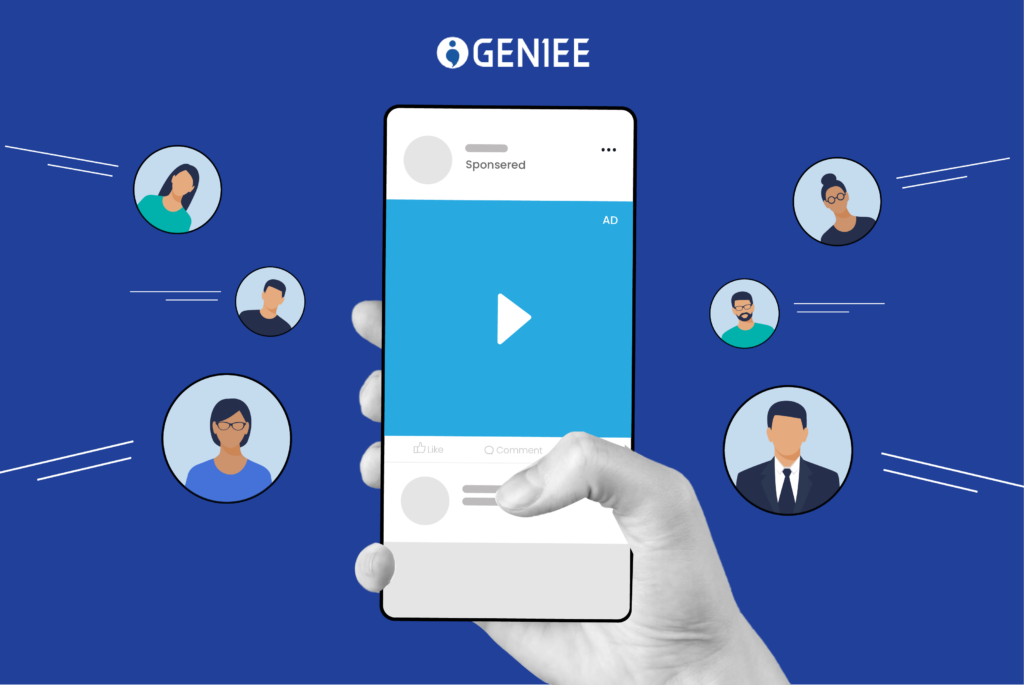
| Discover the power of native video advertising and how it seamlessly integrates into the digital landscape. Explore various types of native video ads, benefits, famous examples, and a comparison with pre-roll ads. |
Advertisers are constantly seeking innovative ways to connect with their target audience, one such method gaining significant traction is native video advertising. Native video advertising has emerged as a powerful tool for engaging audiences. By integrating video content into the user interface, native video ads captivate viewers without interrupting their browsing.
With its ability to blend organically with surrounding content, native video advertising offers brands an effective way to connect with their target audience and drive engagement.
What is Native Video Advertising?
Native video advertising is a form of video advertising where video content seamlessly integrates into the platform or website’s user experience, creating a more cohesive and less disruptive user experience.
Picture this: you’re scrolling through your favorite social media platform or browsing a website, and suddenly, there’s a video that catches your eye. However, it doesn’t feel like an interruption; instead, it feels like a natural part of the content you’re consuming. That’s native video advertising in action.
Unlike traditional ads that scream “Buy me!” or “Click here!”, native video ads take a more subtle approach. They prioritize providing valuable information, education, and entertainment to enhance the user’s online experience.
You might stumble upon them while watching a video on YouTube, scrolling through your Facebook feed, or exploring Instagram stories. They’re tailored to fit each platform, blending into the content you’re already scrolling through.
Native Video Ads: What Types are Here?
Native video ads come in various formats, each tailored to seamlessly integrate with different online environments and engage users effectively.
Pre-roll video ads
The short video commercials play before the main content, such as video ad on YouTube. Pre-roll ads are automatically played before the video content begins, capturing attention from the outset.
It’s essential to ensure that pre-roll ads last no more than 10 seconds, and include a close button option for users who may want to skip the ad. This approach respects users’ time and preferences while still providing the video ads.
In-feed video ads
These videos appear within the feed of a social media platform such as Facebook, Instagram or Twitter. They blend in with other content, like posts from friends or updates from pages you follow.
This integration ensures that the videos feel like a natural part of the user’s browsing experience, maximizing engagement and minimizing disruption. Users are more likely to engage with these in-feed video ads as they scroll through their social media feeds.
In-article ads
These videos play within an article or blog post on a website, fitting seamlessly into the flow of the content and may auto-play as you scroll through the page.
In-article ads serve as sponsored material integrated into the existing content. They are crafted to align with the article’s topic and provide readers with additional information or entertainment value.
In-game ads
These are the video advertisements that appear within video games. They can take various forms, such as product placements (rewarded ads), or short video clips integrated into the gameplay experience. These ads are often non-intrusive and designed to blend in with the game environment.
Outstream ads
Similar to the in-article ads, these video ads appear outside of video content, such as within articles or on social media feeds, typically in between paragraphs of text or in a pop-up window.
Unlike pre-roll ads, they don’t require existing video content to play before. Instead, they play automatically as the user scrolls through the content, typically with sound muted until the user interacts with the ad.
In-banner Video Ads
These are videos that play within a banner ad space on a website. They’re designed to catch your attention without disrupting your browsing experience too much.
More to discover
All About Video Ads: Formats, Setup & Benefits for Publishers

What are the Key Features of Native Video Ads?
Native video ads are characterized by several key features that set them apart from traditional advertising formats.
Seamless integration with the platform’s user experience.
Native video ads seamlessly blend into the platform’s user experience, appearing as natural components of the content environment rather than intrusive interruptions. We can often see them as in-feed content on social media and news articles.
Relevant and engaging content that aligns with the interests of the target audience.
Compared to traditional video ads, native videos offer a more engaging experience for viewers.
These ads deliver content that resonates with the interests and preferences of the target audience, providing valuable information or entertainment value that captures their attention and encourages interaction.
Clear branding and disclosure to distinguish ads from organic content.
Native video ads include clear branding elements and disclosure labels to distinguish them from organic content, ensuring transparency and maintaining trust with viewers.
Optimization for different devices and screen sizes to ensure a consistent viewing experience.
Native video ads are optimized for various devices and screen sizes, offering a consistent viewing experience across desktops, laptops, smartphones, and tablets. This ensures that the ad’s message is effectively conveyed to users regardless of their chosen device.
What are the Benefits of Using Native Video Ads?
Native video ads offer numerous advantages for advertisers and publishers alike. Let’s check it out.
Increase engagement rates.
Native video ads outperform traditional display ads by fostering higher engagement levels and brand recall among viewers.
In a study conducted during a campaign for the soft drink brand Jarritos by Sharethrough and Nielsen, it was discovered that native video ads surpassed pre-roll ads in terms of completion rates. Furthermore, native video ads exhibited an impressive 82% increase in brand lift and purchase intent compared to the pre-roll ads featured in the campaign.

Increased visibility and reach.
Native video ads seamlessly blend into users’ feeds, appearing alongside organic content and maximizing exposure.
Placement on popular platforms like social media or streaming services significantly boosts the visibility and reach of native video ads. For instance, social media platforms such as Facebook, Instagram, and TikTok offer extensive user data bases and robust targeting options, ensuring precise audience reach.
Improved brand perception.
By adopting non-disruptive advertising methods and leveraging storytelling, native video ads contribute to an improved brand name among audiences.
Native video ads often align closely with the interests and preferences of the target audience, further enhancing brand perception. These videos deliver content with compelling narratives and visually appealing presentations that resonate with viewers and add value to their online experience, allowing brands to establish themselves as trusted authorities within their respective industries.
Native Video Ads vs. Pre-roll Ads
Native video ads and pre-roll ads are different in how they work and the effect they have.
Unlike pre-roll ads, native video ads seamlessly integrate into the user experience, becoming part of the content flow rather than interrupting it. This integration enhances engagement and reduces intrusiveness, making native video ads more appealing to viewers.
Overall, native video ads provide a more fluid and engaging advertising experience compared to their pre-roll counterparts. Below is a comparison table outlining the differences between native video ads and pre-roll ads across various categories:
| Category | Native Video Ads | Pre-Roll Ads |
|---|---|---|
| Integration | Seamlessly blend into the user experience | Interrupt content consumption |
| Engagement | More engaging and less intrusive | May be seen as disruptive |
| Duration | Variable, depending on platform and content | Typically have a fixed duration |
| User Experience | Enhances user experience by feeling like natural content | May detract from user experience as an interruption |
| Effectiveness | Often results in higher engagement and brand recall | May have lower engagement due to interruption |
| Flexibility | Can adapt to various lengths and formats | Limited flexibility in terms of duration and format |
| Placement | Integrated within the content flow, appearing as part of the feed | Placed before or during video content, often as an ad |
Some Famous Native Video Ads Examples
Check out these popular native video ad examples, highlighting how this format excels in captivating audiences and fostering engagement.
Final Thoughts on Native Videos
For businesses, native ads provide a pathway to increased engagement, improved user experience, and measurable outcomes. They succeed in capturing attention without being intrusive, fostering brand awareness, and driving conversions through targeted strategies. Publishers also benefit, enjoying higher revenue potential, enhanced user interactions, and valuable insights for refining content strategies.
Looking forward, the future of native video advertising appears promising, with ongoing innovations in formats, storytelling techniques, and targeting capabilities. As brands continue to explore the potential of native video ads, they will find opportunities to connect with audiences in meaningful and engaging ways, further solidifying native advertising’s role as a key component of digital marketing strategies.
Whether your aim is to boost brand awareness or enhance customer loyalty, Geniee is ready to create compelling and immersive native video ads that connect with your target audience.
Frequently Asked Questions:
1. What is native video advertising?
Native video advertising is a form of online advertising where video content seamlessly integrates into the platform or website’s user experience, creating a more cohesive and less disruptive user experience.
2. What are examples of native video ads?
Examples of native videos include in-feed video ads on social media platforms like Facebook and Instagram, sponsored video content within articles or blog posts on websites, and video ads incorporated into mobile apps or games.
3. What are native video ad types?
Native video ad types encompass various formats, such as in-feed ads, in-article ads, in-game ads, outstream ads, and native mobile video ads. These ads are designed to blend in with the surrounding content and provide a seamless viewing experience for users.
4. Are native video ads more expensive than traditional display ads?
Native video ads can be more expensive due to their higher engagement rates and production costs, but they often deliver better results in terms of brand awareness and conversions.
5. How can I measure the effectiveness of native video ads?
Key metrics for measuring the effectiveness of native video ads include view count, engagement rate, click-through rate, and conversion rate. Advertisers can also use A/B testing and audience surveys to evaluate the impact of their campaigns.
6. Are there any best practices for creating native video ads?
Best practices for creating native video ads include focusing on storytelling, keeping videos short and engaging, optimizing for mobile viewing, and integrating branding subtly into the content.

0 Comments